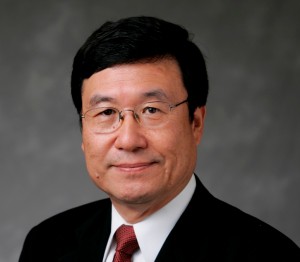Justin’s Japan: Interview with author Hideo Dan on ‘Lipstick Building’

- Meet ‘Lipstick Building’ author Hideo Dan at Manhattan’s Kinokuniya Bookstore Saturday, Dec. 11. (Courtesy of Hideo Dan)
By JQ magazine’s Justin Tedaldi (CIR Kobe-shi, 2001-02) for Examiner.com. Visit his NY Japanese Culture page here to subscribe for free alerts on newly published stories.
Hideo Dan is a vice president and attorney at law of a New Jersey-based healthcare company who is now a debut author. Published by NY Seikatsu Press, Lipstick Building is a fast-paced suspense novel based on the author’s 30-year real-life experience in New York as a shosha (trading company) man and a corporate attorney with an international law firm.
Kenji Kadota, who works for a Japanese trading company in New York, is introduced at a party to Suzanna, a beautiful businesswoman from Peru. She proposes a big business opportunity to Kenji—an attractive prospect of exporting Japanese machinery to a major Peruvian construction company. Is this a great business chance, or is something ominous ahead? The story develops quickly into intrigue and adventure, with Kenji and Suzanna crisscrossing through South America and Europe, providing readers entertainment and thrills to the end.
The author will be the subject of a special talk and book signing event Saturday, Dec. 11 at Manhattan’s Kinokuniya Bookstore. I caught up with him to learn more.
How did you come to the U.S.?
The first time I came to the U.S. was in 1971, when I attended Indiana University for a year to study journalism. I could not land a job in journalism, so I started to work for Nissho-Iwai, a trading company, a.k.a. shosha, upon graduation from Osaka University with a law degree. In 1979, Nissho-Iwai sent me to its New York subsidiary as legal manager.
Lipstick Building is based on your three decades of experience at a Japanese trading company. How long did it take to write this book?
Actually, I was with the trading company for 14 years, seven years each for Japan and New York. After that, I left the company and joined a law firm in New York, having had passed the New York Bar Exam while I was with Nissho-iwai American Corporation. After almost nine years with the law firm, I joined Eisai, a Tokyo-based pharmaceutical company, as general counsel for its U.S. operations.
It took nearly one and a half years to write this book. I was able to do it since I was asked to manage Eisai USA Foundation, a charitable organization on the part-time basis, two years ago.
What is your personal experience with Peru? Are there any other international experiences that helped your writing?
Unfortunately, I have never been to Peru—I was planning to do so this year but because of the flood at Machu Picchu, my trip was cancelled. So I did lots of research on Peru on Google and at a library. I had met a very attractive Peruvian student when I was attending Indiana University, which gave me some inspirations for this book. In fact, Europe (Spain and Switzerland) plays a much larger part in this story than Peru. I have been to Spain and Switzerland on business and pleasure on numerous occasions and have been attracted by culture and scenery in those countries. Especially in Spain—I was fascinated by flamenco and its dancers. Flamenco is an important element in this novel.
What are the big differences between working at a trading company in Japan versus the U.S.? Did these differences shape the story?
At the trading company in New York and also at the law firm where I worked, naturally I interacted heavily with non-Japanese people, colleagues and clients, which constantly reminded me of cultural and linguistic differences between Japan, the U.S. and many other different cultures. As someone who is very curious about anything, I enjoyed learning those differences on daily basis. At the same time, I got impressed with striking similarities at a deep human level. My book certainly reflects those experiences and observations.
Click here for the rest of the interview.


Comments are closed.